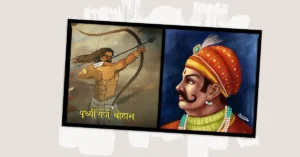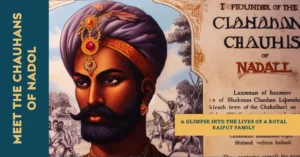Jalore was called Jabalipur because it was the penance place of sage Jabali. Jalore Fort is situated on Songiri hill. That is why it is also called Songadh, Suvarnagiri and Kanchangiri. Due to abundance of Jaal trees it was called Jalore.
The Chauhans of Jalore, also known as the Chauhans of Jalore in vernacular legends, were a Rajput dynasty that ruled the area around Jalore in present-day Rajasthan between 1160 and 1311 CE.
They belonged to the Chahamana (Chauhan) clan of the Rajputs. They branched off from the Chahamanas of Naddula, and then ruled as feudatories of the Chaulukyas of Gujarat.
For a brief period, they became independent, but ultimately succumbed to the Delhi Sultanate at the Siege of Jalore.
Chauhan Kings in Jalore
Keertipal
In 1181 AD, the rule of Songara branch of Chauhan dynasty started/established in Jalore by Keertipal. He captured Jalore by defeating Kuntpal Parmar. This branch of Chauhans was called Songara due to their control over Songiri Fort.
Keertipal defeated Samant Singh of Chittor.
According to Nainasi’s fame, Keetu (Kirtipala) was a great king. In the inscriptions of Sundha Mountain it has been called Rajeshwar.
The following table lists the names and reigns of the Chauhan kings of Jalore, along with their notable achievements and events:
| Name | Reign | Achievements and Events |
|---|---|---|
| Keertipal | c. 1160-1182 CE | The founder of the dynasty, he was a grandson of Rao Deoraj and a scion of the younger branch of the Chauhan rulers of Jalore. He seized the town of Abu from the Parmars, and thus founded a dynasty that was to rule the surrounding area for over six centuries. He also built the Achaleshwar Mahadev Temple, dedicated to Lord Shiva. |
| Samar Singh | c. 1182-1204 CE | He was a son of Keertipal, and succeeded him as the ruler of Jalore. He fought against the Delhi Sultanate, and allied with the Mewar king Lakshman Singh against the Sultan Jalal ud din Firuz Khilji. |
| Uday Singh | c. 1204-1257 CE | He was a son of Samar Singh, and succeeded him as the ruler of Jalore. He was a patron of art and culture, and invited several poets and scholars to his court. He also built the Sirohi Fort, and the Sarvadham Temple, dedicated to various Hindu deities. |
| Chachigdev | c. 1257-1273 CE | He was a son of Uday Singh, and succeeded him as the ruler of Jalore. He retained the territories he inherited. |
| Samant Singh | c. 1273-1305 CE | He was a son of Chachigdev, and succeeded him as the ruler of Jalore. He was a brave and ambitious ruler, who expanded his kingdom by conquering several neighbouring territories. He also built the Jagmal Sagar, a large lake near Jalore. |
| Kanhad dev | c. 1305-1311 CE | He was a son of Samant Singh, and succeeded him as the ruler of Jalore. He was a valiant and devout ruler, who defended his kingdom against the attacks of the Gujarat Sultanate and the Delhi Sultanate. He also performed several yajnas and pilgrimages. |
| Kanhaddev V/S Alauddin Khilji | – | The most famous event of Kanhaddev’s reign was his conflict with the Delhi Sultan Alauddin Khilji, which resulted in the fall of Jalore in 1311 CE. The reasons of the conflict were: \n – Kanhaddev had given shelter to the rebel Rathore prince Chanda, who had fled from the Mewar king Ratan Singh after killing his brother Hammir Singh. \n – Kanhaddev had also given refuge to the widow and son of the Gujarat king Karan Vaghela, who had been killed by Alauddin Khilji in 1299 CE. \n – Kanhaddev had refused to pay tribute to Alauddin Khilji, and had asserted his independence. |
| Alauddin Khilji’s attack on Siwana – 1308 AD | – | Alauddin Khilji sent a large army under his general Malik Kamaluddin Gurg to subjugate Jalore in 1308 CE. The army first attacked Siwana, a fort near Jalore, which was defended by Kanhaddev’s son Viramdev. The siege lasted for several months, and resulted in heavy casualties on both sides. Viramdev and his men fought valiantly, but were ultimately killed by the invaders. The fort was plundered and destroyed by the Mughals. |
| War of Malkana | – | After the fall of Siwana, Kanhaddev formed a confederacy with the neighbouring Rajput rulers, such as the Guhilas of Mewar, the Chauhans of Sirohi, the Paramaras of Chandravati and other rulers of Marwar. The confederacy attacked the Mughal army at Malkana, a plain near Jalore, in 1309 CE. The battle was fierce and bloody, and lasted for several days. The Rajputs inflicted heavy losses on the Mughals, but were unable to break their ranks. The Mughals also received reinforcements from Delhi, which turned the tide of the battle in their favour. The Rajputs were forced to retreat, and many of them were killed or captured by the Mughals. |
| Allauddin Khilji’s invasion of Jalore – 1311 AD | – | Alauddin Khilji himself led a massive army to invade Jalore in 1311 CE. He laid siege to the Jalore Fort, which was defended by Kanhaddev and his sons. The siege lasted for eight months, and witnessed several heroic deeds and sacrifices by the Rajputs. Kanhaddev and his sons were killed in the battle, along with many other Rajput warriors. The fort was captured by the Mughals, who massacred the remaining defenders and civilians. The women of the fort performed jauhar (self-immolation) to avoid capture by the invaders. The fall of Jalore marked the end of the Chauhan dynasty of Jalore, and the beginning of the Mughal rule in Marwar. |
Conclusion
The Chauhans of Jalore were a powerful and illustrious Rajput dynasty that ruled the Jalore region for over two centuries. They were known for their courage, generosity, piety, and patronage of art and culture.
They left behind a rich legacy of architecture, painting, and literature, which can be seen in their capital Jalore and other places. They were also instrumental in resisting the foreign invasions and preserving the Rajput identity and pride.
They are remembered as one of the glorious dynasties of Rajasthan and India.
- Jaita Devada :- Commander of Kanhaddev.
- Firoza :- Alauddin’s daughter who liked Veeramdev.
- Gul Vihisht :- Firozha’s foster mother.
- Kanhadde Prabandha (book)
- Veeramdev Songara’s story (story)



